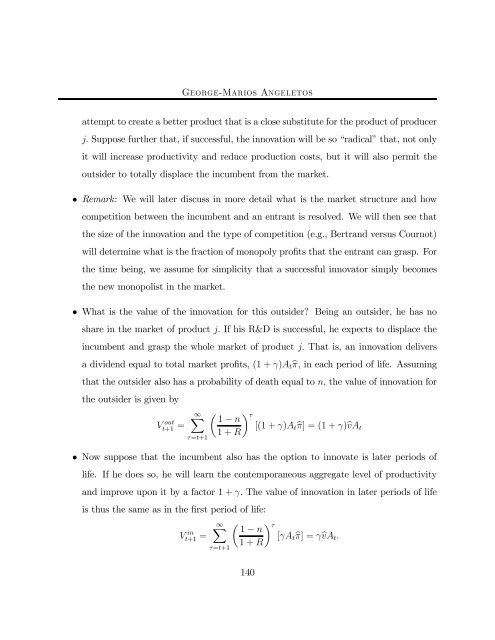14.451 Lecture Notes Economic Growth
14.451 Lecture Notes Economic Growth
14.451 Lecture Notes Economic Growth
You also want an ePaper? Increase the reach of your titles
YUMPU automatically turns print PDFs into web optimized ePapers that Google loves.
George-Marios Angeletos<br />
attempt to create a better product that is a close substitute for the product of producer<br />
j. Suppose further that, if successful, the innovation will be so “radical” that, not only<br />
it will increase productivity and reduce production costs, but it will also permit the<br />
outsider to totally displace the incumbent from the market.<br />
• Remark: We will later discuss in more detail what is the market structure and how<br />
competition between the incumbent and an entrant is resolved. We will then see that<br />
the size of the innovation and the type of competition (e.g., Bertrand versus Cournot)<br />
will determine what is the fraction of monopoly profits that the entrant can grasp. For<br />
the time being, we assume for simplicity that a successful innovator simply becomes<br />
the new monopolist in the market.<br />
• What is the value of the innovation for this outsider? Being an outsider, he has no<br />
share in the market of product j. If his R&D is successful, he expects to displace the<br />
incumbent and grasp the whole market of product j. That is, an innovation delivers<br />
a dividend equal to total market profits, (1 + γ)Atbπ, in each period of life. Assuming<br />
that the outsider also has a probability of death equal to n, the value of innovation for<br />
the outsider is given by<br />
V out<br />
t+1 =<br />
∞X<br />
τ=t+1<br />
µ τ<br />
1 − n<br />
[(1 + γ)Atbπ] =(1+γ)bvAt<br />
1+R<br />
• Now suppose that the incumbent also has the option to innovate is later periods of<br />
life. If he does so, he will learn the contemporaneous aggregate level of productivity<br />
and improve upon it by a factor 1+γ. The value of innovation in later periods of life<br />
is thus the same as in the first period of life:<br />
V in<br />
t+1 =<br />
∞X<br />
τ=t+1<br />
µ 1 − n<br />
1+R<br />
140<br />
τ<br />
[γAtbπ] =γbvAt.

















